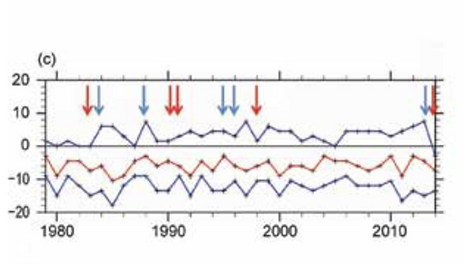
Natural Causes
Humans are utterly helpless in front of mother nature.
Extreme weather can be a naturally occurring phenomenon. An abnormal climate is caused by a causal chain of a series of natural phenomena. From this perspective, we focus on the phenomena occurring in the Earth's cycle rather than the phenomena caused by human pollution.


Hotter, Longer Heatwaves
Researchers have reported that the hot weather has more than doubled over the past 50 years. In addition, it was also found that the heat dome phenomenon contributed greatly to the heat waves.

More Persistent Droughts
If the heat wave worsens, the drought will naturally get worse, which leads to abnormal weather conditions. During the heatwave, it rains less, and the moisture on the ground dries up faster, then this makes the ground hotter.


More extreme rainfall events
In general, hot weather creates moisture and water vapor, and the water vapor and moisture created thereby turn into droplets to make rain. However, as the weather gets warmer, more steam is created in the atmosphere. As a result, more water droplets and more rain fall.

3 Examples and Explains

1) UK extreme storm season, winter 2013-14
(“The all-time record number of storms over the British Isles in winter 2013/14 cannot be linked directly to *anthropogenic-induced warming of the tropical west Pacific” - Explaining Extreme Events of 2014 from a Climate Perspective - Stephanie C. Herring, Martin P. Hoerling, James P. Kossin, Thomas C. Peterson, and Peter A. Stott), (*anthropogenic: originating from human activity)

-
Low pressure system has lower pressure at its center than the areas around it. Winds blow towards the low pressure, and the air rises in the atmosphere where they meet. As the air rises, the water vapor within it condenses, forming clouds and often rain. A series of low pressure areas formed over North America explosively deepening over the Atlantic before reaching the European coast. An Omega Block (An Omega Block is an upper-level atmospheric pattern with two areas of lower pressure on either side of a warmer, high-pressure area) developed over northern Norway/Scandinavia which prevented the lows moving east over Europe, with a series of lows "dying" to the northwest of Britain and Ireland → storm surges
-
Average sea-level pressure is 1013.25 hPa, however according to the graph, the sea level pressure occasionally drop below 990, even to the min point of under 950
-
Except for the storm of 12 February, the other storms were individually not exceptional for a typical UK winter → variability → suggest that there are no human-related signs



-
Based on the chart of the “Advanced risk-based event attribution for heavy regional rainfall events” from Nature, we can see the return period for the event was around 100 years, which means this is unlikely to be a pattern cause by human activities, and more likely of a natural variability
-
A monsoon gyre is a very large low-level cyclonic vortex which is episodic in nature and once formed can last up to two weeks and generate tropical cyclones, occur at Northwest Pacific Ocean, where Japan is located → episodic nature event → further adds that there are no anthropogenic signs here
-
+) out of 6 storms in the whole 1993 that pass through and affect Japan, 3 of them was in July (Nathan, Percy, Ofelia) → high precipitation for July
-
+) Intense winds can converge at the centre of a low pressure system and then rise. The air cool as they move upwards, so condensation takes place, clouds are formed and precipitation occurs (during storm Ofelia, max wind gusts on Okinawa — 49 kt and northern Ryukyu Islands reported max wind gusts of 69 kt → cause massive rain)
2) Heavy rainfall over western Japan, July 1993
(“Extreme rainfall…was not attributable to anthropogenic climate change because the occurrence of heavy rainfall depended more on the tropical cyclone approach rather than on the moisture increase due to global warming.” - Advanced risk-based event attribution for heavy regional rainfall events - Nature)

3) Singapore record dry spell, Feb 2014
-
The Inter Tropical Convergence Zone (ITCZ) is a belt of low pressure which circles the Earth generally near the equator where the trade winds of the Northern and Southern Hemispheres come together, characterized by convection. Low pressure area usually causes rain, the ITCZ is a low pressure area, however, it reached its furthest southward location in that month and thus had less effect on Singapore’s rainfall

-
Graph from American Meteorological Society: Time series of the latitude of the northern edge (upper purple line), maximum value, and southern edge of the ITCZ, averaged between 98°48’E and 108°48’E, averaged over the month of Feb, from ERA-Interim analyses. Red arrows denote the years of the dry seasons. The final red arrow is 2014, with the northern boundary (upper purple line) of the ITCZ at its most southernmost point, even below the equator → far away from Singapore
-
Madden–Julian oscillation (MJO) is an eastward moving disturbance of clouds, rainfall, winds, and pressure that travels across the planet in the tropics and returns to its initial starting point; it has 2 phases, a rainfall phase and a dry phase.
-
Graph of American Meteorological Society: February rainfall (mm) averaged over an 8 station network since 1965. Black circles denote years with greater than 50% time in MJO dry phase, Green circles denote when the mean location of the Northern edge of ITCZ is south of equator → The 2014 dry spell was made off 2 circles, the dry MJO and the ITCZ

“The record dry spell over Singapore–Malaysia was caused by the southward contraction of the intertropical convergence zone and the Madden Julian Oscillation. Within present evidence, there is no clear attribution to climate change.” - Explaining Extreme Events of 2014 from a Climate Perspective - Stephanie C. Herring, Martin P. Hoerling, James P. Kossin, Thomas C. Peterson, and Peter A. Stott